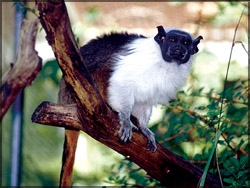|
Marmosets and tamarins II:
World's tiniest monkeys
 Those
of you who read last week's Nature Trail may have been fascinated by the
species of monkeys we introduced through the page. Marmosets and tamarins who hold the record as the world's tiniest monkeys are indeed
exotic creatures and many are kept as pets. Those
of you who read last week's Nature Trail may have been fascinated by the
species of monkeys we introduced through the page. Marmosets and tamarins who hold the record as the world's tiniest monkeys are indeed
exotic creatures and many are kept as pets.
Perhaps,
you too would love to have one of them as a pet, but these types of
animals, unlike cats and dogs, are best left in their own natural
environments. They should be allowed to live freely in the wilds because
their lifestyles are very different to that of cats or dogs we bring up
at home.
Today,
let's check out a few species of marmosets and tamarins that live in the
Amazon forest in South and Central America. As we mentioned in last
week's article, these creatures which are called New World Monkeys
belong to the genus Callithrix.
There are
many species of both marmosets and tamarins and most of them are either
threatened or endangered.
As
marmosets and tamarins are diverse and colourful, with each species
having unique tufts, manes or moustaches, we feature some fascinating
pictures and facts of a few of them to improve your knowledge of the
various animals that live virtually hidden from our sight...
Emperor tamarins (Oaguinus
imperator)
The name is certainly an unusual one for an inhabitant of the animal
kingdom. It is believed that when this creature was first discovered,
people had jokingly referred to it as the 'emperor' due to its
similarities in appearance to the German Emperor Wilhelm II.
Now, it has become the official scientific name for the animal.
Nothing more than 24-26 cm in length, with a tail that's much longer,
about 35 cm, what's unique about this species of tamarin is its white
drooping moustache, which extends to both sides beyond the shoulders. It
has
|

A baby(left) and adult Emperor tamarin |
tufts of hair on the ears too. It weighs around 300-400 grammes.
 There
are two subspecies; the black-chinned emperor tamarin and the bearded
emperor tamarins. The black-chinned emperor tamarins which may also have
beards are considered vulnerable. They were first discovered at the
beginning of this century. There
are two subspecies; the black-chinned emperor tamarin and the bearded
emperor tamarins. The black-chinned emperor tamarins which may also have
beards are considered vulnerable. They were first discovered at the
beginning of this century.
The reason they are endangered is mainly due to the destruction of
their environment. Like all tamarins, emperor tamarins too have silky
fur, which is predominantly grey or brown in colour, with yellow
speckles on the chest. Hands, feet and cap are black, but the tail is a
reddish brown or almost orange in colour.
|

The bearded emperor tamarin |
|

The black-chinned emperor tamarin |
Found mostly in the range of Brazil and Peru, they prefer to live in
lowland, evergreen, broad leaf forests and densely grown forest margins.
During the wet season, it survives on small portions of nectar, sap and
fungi, but during the dry season, nectar becomes the most important part
of the diet.
It also eats fruits, sap, flowers, ants and even snails. Emperor
tamarins have a lifespan of about 17 years and make graceful, friendly
and playful exotic pets. They are very active during the day. They love
to be stroked by hand, and in fact, lie on their backs for extra petting
when being stroked.
Lion tamarins (Leontopithecus rosalia)
Four species make up the genus Leontopithecus named so for the mane
surrounding their faces which is similar to that of the lion's. One
species L-caissara was discovered in 1900.
They are about 28-30 cm long with tails of about 45 cm. Both males
and females look alike. The long, soft, silky fur ranges from a pale
gold to a richer red gold. The fur is similar to a cat's fur.
They have black markings on the feet and tails. The hands and feet
are narrow and long. The elongated fingers
|

The golden lion tamarin |
are as long as their fore arms! They weigh about 900 gm (2
lbs).
Like all tamarins, they are arboreal and very agile. They can jump
from branch to branch. They are not only active, but also very vocal.
However, their vocalizations are very soft, except for their squeal of
alarm.
These species of tamarins are critically endangered because 99 per
cent of prime forests are being cut down, destroying their natural
habitats. They are also being exploited in the pet trade, zoos and
laboratories.
Fact: There are 12 species of tamarins in the genus Saguinus and
though the other species lack manes like the four types of Lion tamarins,
they have notable features like scruffy tops, moustaches and beards.
Goeldi's
marmosets (Callimico goeldii)
Named after its discoverer, a Swiss naturalist Emil August Goeldi, it
is found mostly in Bolivia, Brazil, Colombia and Peru. In 2003 it was listed as vulnerable, but now it's not.
and Peru. In 2003 it was listed as vulnerable, but now it's not.
With fur coats ranging from a blackish-brown to black, these species
of monkeys, believed to have been identified around 1904, are considered
a rare species. They are around 8-9 inches long with tails of about
10-12 inches.
Cotton-top tamarins (Saguinus oedipus)
Categorised in the bare faced group of tamarins, the cotton-top
tamarins are also known as the cotton headed tamarins or white-plumed
tamarins.
Their characteristic feature is the long white hair on the head. Even
though there is fine white hair on the faces, they appear to be bare and
are black in colour because only the skin shows.
 The
stomach and limbs are white. They have reddish-brown hair on the back
thighs and base of the tails. Other parts of the tails are grey, brown
and black. The
stomach and limbs are white. They have reddish-brown hair on the back
thighs and base of the tails. Other parts of the tails are grey, brown
and black.
Cotton-top tamarins weigh about 410-450 g and grow to a length of
nearly 10 inches. Unlike the rest of the species, the cotton-tops are
known to give birth to non-identical or fraternal twins.
Found mostly in humid, tropical forests, dry, deciduous forests and
secondary growth forests, these tamarins are extremely vigilant. They
are constantly scanning for potential predators. When the rest of the
group sleeps, one keeps vigil during the day.
At night, they sleep in tree holes. But, they are up and ready for
action about 1 1/2 hours after dawn. The entire group could be seen
leaving their 'sleep tree' at the same time.
Fact: Tamarins are
characterised into three groups by their facial expressions. They are;
the bare-faced tamarins, hairy faced tamarins and mottle-faced tamarins.
Bare-faced tamarins (Saguinus bicolour)
The Brazilian bare-faced tamarin, pied bare-faced tamarin, pied
tamarin is listed as critically endangered and
|

The Brazilian bare-faced tamarin |
facing an extremely high risk of becoming extinct in the wild.
This species is found in a small region, north of the Amazon river in
Brazil.
They prefer secondary forests, swamps, and sand forests. Usually they
can be spotted up in the canopy about 10-12 metres high. Named for their
black, hairless face and ears, they have variable fur colours such as
brown, black or silver depending on the subspecies.
It is believed that members of this genus could live long lives;
perhaps up to 20 years or more. These tamarins are utilised for food in
the region of Manaus.
Pygmy marmosets
|

The smallest of them all - A baby and adult Pygmy mamoset |
Pygmy marmosets found in the upper Amazon of Colombia, Peru, Ecuador,
Bolivia and Brazil live in groups in territories ranging from 25-100
acres. They are the smallest true monkeys even among the marmosets and
so, become the
 tiniest
in the world! tiniest
in the world!
They are about 14-16 cm in length with tails of 15-20 cm. The males
weigh about 5 ounces and the females are about 4.2 ounces. As the pygmy
marmosets are somewhat different to the rest of the marmosets, they were
accorded their own sub-genus - Cebulla.
There are two sub species of pygmy marmosets. They have tawny coats,
ringed tails as long as their bodies and claws specially adapted for
climbing trees. In fact, their claws are unique to their species. |
